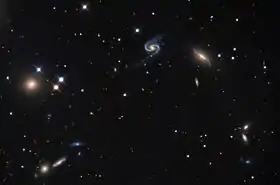NGC 90
NGC 90 is an interacting spiral galaxy estimated to be about 300 million light-years away in the constellation of Andromeda. It was discovered by R. J. Mitchell in 1854 and its apparent magnitude is 13.7.[3] The galaxy is currently interacting with NGC 93 and exhibits two highly elongated and distorted spiral arms with bright blue star clusters indicative of star formation, likely caused by the interaction with its neighbor.
| NGC 90 | |
|---|---|
 NGC 90 (top center) and its spiral companion to the right, NGC 93 Credit: Mount Lemmon SkyCenter using the 0.8m Schulman Telescope | |
| Observation data (J2000 epoch) | |
| Constellation | Andromeda |
| Right ascension | 00h 21m 51.4s [1] |
| Declination | +22° 24′ 00″[1] |
| Redshift | 0.017856[2] |
| Helio radial velocity | 5353 ± 10 km/s[2] |
| Distance | 333.8 ± 146 Mly (102.35 ± 44.76 Mpc)[2] |
| Apparent magnitude (V) | 13.7 [3] |
| Characteristics | |
| Type | SAB(s)c pec [2] |
| Apparent size (V) | 2.4' x 0.91' [2] |
| Other designations | |
| UGC 208, MCG+04-02-011, PGC 1405,[2] Arp 65 | |
NGC 90 and NGC 93 form the interacting galaxy pair Arp 65.
References
| Wikimedia Commons has media related to Arp 65. |
- Skrutskie, M. (2006). "The Two Micron All Sky Survey (2MASS)". The Astronomical Journal. 131 (2): 1163–1183. Bibcode:2006AJ....131.1163S. doi:10.1086/498708.
- "NED results for object NGC 0090". National Aeronautics and Space Administration / Infrared Processing and Analysis Center. 2008. Retrieved 24 November 2008.
- "NGC Objects: NGC 50 - 99".
This article is issued from Wikipedia. The text is licensed under Creative Commons - Attribution - Sharealike. Additional terms may apply for the media files.
